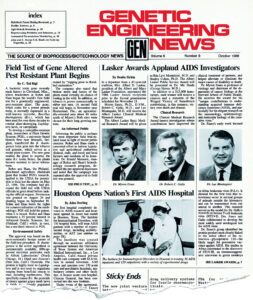EDITOR’S NOTE: During biotech’s early days, there were a number of concerns about the new field, especially regarding the safety of recombinant DNA. Indeed, then Stanford biochemist Paul Berg organized the Asilomar Conference on Recombinant DNA in February 1975 to discuss the potential biohazards and regulation of biotechnology. Voluntary guidelines to ensure the safety of recombinant DNA technology were created. These guidelines and subsequent regulations helped inspire confidence in biotech. For example, biotech has become a successful part of the pharma industry. However, in agriculture, biotech still encounters resistance from those who call GMO crops “Frankenfoods.” Hence, the story below, which highlights safety concerns, remains timely.

A bacterial toxin gene recently made history in Cleveland, MS, where researchers at Rohm and Haas began the world’s first field test for a genetically engineered, pest-resistant plant. The gene, which codes for a potent protein toxin, is normally expressed in a well-known microbe, Bacillus thuringiensis (Bt), which has been used for over three decades to combat plant-destroying Lepidoptera larva, or caterpillars.
To develop a caterpillar-resistant plant, researchers at Plant Genetic Systems (PGS), a university-based biotech firm near Brussels, Belgium, transferred the Bt toxin gene into the tobacco cell genome, which serves as a model plant system. The new gene enables the plant to express the same Bt toxin; hence, the plants become resistant to larval infestations.
Rohm and Haas, the Philadelphia-based agriculture chemicals giant that funded PGS’s research, applied to the USDA for permission to field test the plants on May 23, 1986. The company had discussed the field test with USDA officials in great detail before making the official request. Permission was granted on August 26, and planting began on September 10. Rohm and Haas holds the rights for commercialization of the methodology; PGS will hold the patent, when it is issued. Rohm and Haas maintains a 15% interest in Advanced Genetic Sciences (Oakland, CA), which itself has a one-third interest in PGS.
The approval was based on the environmentally benign nature of the field test procedure. Bt is the active ingredient in commercially available, EPA-approved microbial pesticides such as Abbot Laboratories’ (North Chicago, IL) Dipel and Zoecon’s (Palo Alto, CA.) Thuricide. The protein is highly toxic to Lepidoptera and nontoxic to animals ranging from beneficial insects to earthworms to man. This specificity makes Bt the pesticide of choice against gypsy moth larva in fields near densely populated cities.
A second key issue in field test approvals is the trackability of genetically altered organisms. Tracking these gene-altered plants is feasible—they’ll be up to two feet tall and rooted. Rohm and Haas’s test procedures mandate that flowering and pollen production will be prevented by “topping prior to floral-bud maturation.”
The company also stated that broken stems and leaves of the plants stand virtually no chance of rooting in the wild. In addition, no tobacco is grown commercially in either test area. (A second field trial will begin in November near Homestead, FL, an agriculturally oriented area about 40 miles south of Miami, FL). Both sites were chosen for their long growing seasons.
